
This lesson reviews how to change an improper fraction to a mixed number.
- Subject:
- Mathematics
- Material Type:
- Lecture
- Provider:
- Khan Academy
- Provider Set:
- Khan Academy
- Author:
- Salman Khan
- Date Added:
- 02/20/2011

High quality mathematics resources for remote high school learning from the CK-12 Foundation, EngageNY, Illustrative Mathematics, and Khan Academy. You can refine the collections by selecting different fields, such as material types, on the left side of the page, under Filter Resources.

This lesson reviews how to change an improper fraction to a mixed number.

The purpose of the task is to connect properties of fractional exponents with ordering of real numbers. One can place the numbers on the number line to emphasize this.
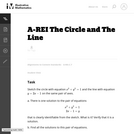
Although this task is fairly straightforward, it is worth noticing that it does not explicitly tell students to look for intersection points when they graph the circle and the line. Thus, in addition to assessing whether they can solve the system of equations, it is assessing a simple but important piece of conceptual understanding, namely the correspondence between intersection points of the two graphs and solutions of the system.
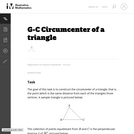
This task shows that the three perpendicular bisectors of the sides of a triangle all meet in a point, using the characterization of the perpendicular bisector of a line segment as the set of points equidistant from the two ends of the segment. The point so constructed is called the circumcenter of the triangle.
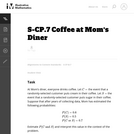
This task assesses a student's ability to use the addition rule to compute a probability and to interpret a probability in context.

The primary purpose of this problem is to rewrite simple rational expressions in different forms to exhibit different aspects of the expression, in the context of a relevant real-world context (the fuel efficiency of of a car). Indeed, the given form of the combined fuel economy computation is useful for direct calculation, but if asked for an approximation, is not particularly helpful.

This task gives students an opportunity to work with exponential functions in a real world context involving continuously compounded interest. They will study how the base of the exponential function impacts its growth rate and use logarithms to solve exponential equations.
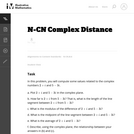
This problem is intended to reinforce the geometric interpretation of distance between complex numbers and midpoints as modulus of the difference and average respectively.
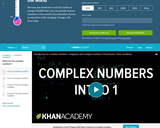
This 4-minute video lesson introduces Khan's series on complex numbers.
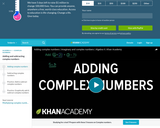
This single minute video lesson looks at how to add complex numbers.
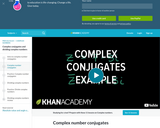
This 4-minute video lesson give an example of a complex conjugate.
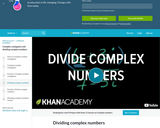
This 5- minute video lesson shows how to divide complex numbers.

This 4-minute video lesson looks at the imaginary roots of negative numbers.
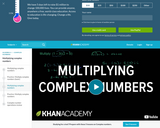
This 6-minute video lesson explains how to multiply complex numbers.
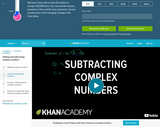
This 2-minute video lesson explains how to subtract complex numbers.

This task is preliminary to F-LE Compounding Interest with a 5% Interest Rate which further develops the relationship between e and compound interest.
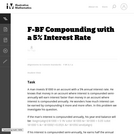
This task develops reasoning behind the general formula for balances under continuously compounded interest. While this task itself specifically addresses the standard (F-BF), building functions from a context, a auxiliary purpose is to introduce and motivate the number e, which plays a significant role in the (F-LE) domain of tasks.
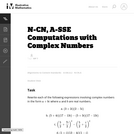
This task asks students to perform computations involving complex numbers using the given information.

This 6-minute video lesson looks at 2010 IIT JEE Paper 1 Problem 45 Circle Hyperbola Common Tangent.

This 11-minute video lesson continues to look at 2010 IIT JEE Paper 1 Problem 45 Circle Hyperbola Common Tangent.